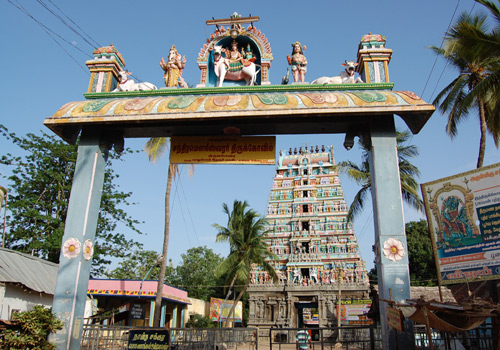Tiruvakkarai Sri Chandramouleeswar Temple, Villupuram

Diety: Chandramouleeswarar, Amman: Amirthambagai
Temple Address: Tiruvakkarai Sri Chandramouleeswar Temple,Tiruvakkarai,Vanur Taluk, Villupuram District PIN 604304
Open between: 06:00 AM to 12:00 PM and 04:00 AM to 08:30 AM
Introduction
Chandramowleeswarar Temple, Thiruvakkarai (also called Piraisoodiya Emperuman or Vakrakali temple) in Thiruvakkarai, a village in Villupuram district in the South Indian state of Tamil Nadu, is dedicated to the Hindu god Shiva. Constructed in the Dravidian style of architecture, the temple is believed to have been built during the Cholas period in the 10th century. The temple has received gracious endowments from the Chola queen Sembiyan Mahadevi. Shiva is worshipped as Chandramowleeswarar and his consort Parvathi as Amirthambigai.The presiding deity is revered in the 7th century Tamil Saiva canonical work, the Tevaram, written by Tamil saint poets known as the Nayanmars and classified as Paadal Petra Sthalam. A granite wall surrounds the temple, enclosing all its shrines. The temple has a seven-tiered Rajagopuram, the gateway tower.
Puranic Significance
The exact year of building could not be ascertained from the inscriptions, but the stone structure of Chandramowleeswarar shrine in its current form, is built during the time of Chola king Aditya I (870 – 907 CE). The inscriptions on the two sides of the Southern shrine of the temple indicate an endowment from Aditya for perpetual lighting of lamps in the temple. Theerthavari, the sacred bathing of the presiding deity during the auspicious days in the Tamil month of Puratasi (September – October). The temple has another inscription in the second precinct during the time of Uttama Chola (970-985 CE) for the maintenance and worship of Chandramowleeswarar and Varadaraja Perumal afforded to four able men. During the reign of Raja Raja Chola I (984-1015 CE), a village named Manali was gifted to the temple – the inscription indicates that the temple was built by Sembiyar Mahadevi. The structure of the Vishnu shrine is believed to have expanded during the reign of Rajendra Chola I (1012-1044) As per Hindu legend, Vishnu killed a demon king Vakrasura. Kali destroyed Vakrasura’s sister Dhunmuki. Since Dhummuki was pregnant, she pulled out the child from the womb and wore it as an ear ring in her right ear. Since Kali slayed the sister of Vakrasura, she came to be known as Vakrakali and the place came to be known as Thiruvakkarai. It is believed that Adi Shankara quelled her anger by installing a Srichakra in her left leg. The place is called Vakra Shanti Tiruthalam. The shrine of Kali is modelled similar to the Durga shrine at Thenupuriswarar Temple at Patteeswaram, Brahma Chamundeeswari Chidambaram and Thillai Kali at Chidambaram. Usually Kali temples are located in the outskirts of the village, but the shrine of Kali is located inside a Shiva temple only at Thiruvakkarai.
Special Features
The temple in its current structure built of stone was built by the Chola king Aditya I (870 – 907 CE). The temple has a seven-tiered Rajagopuram, the gateway tower that pierces the rectangular wall that houses all the shrines. The temple tank is located adjacent to the temple. The sanctum sanctorum houses the one of the rare image of Chandramowleeswarar in the form of Lingam, an iconic form of Shiva with three faces, said to be of the very few in India. There is an Ardha Mandapa and a Mukha mandapa, pillared halls leading to the sanctum. The first precinct has the shrines of Vinayakar, Murugan, Durga, Dakshinamurthy and Chandikeswara. The second precinct has a hundred pillared hall. Architecturally there are many things in this temple that are contrary to tradition. Generally, one can have the darshan of the main deity from the entrance itself, however, in this temple the main deity is not visible as the Moolavar is not in a straight line. In fact, none of main features of the temple—the Rajagopuram, flag post, Nandhi—are on a straight line and are found slightly away from one another. Also, unlike other temples the Sani Bhagavan’s Vahanam, the crow is facing the left side as opposed to the normal right side. All these are attributed to the vakram nature (contradictory) of the temple.There is a separate shrine for Varadaraja Perumal Lord Vishnu and the idol has the unique feature of Prayoka Chakra, this cannot be seen elsewhere and the shrine for vakra Kali in the second precinct.
Festivals
The Chitrapournami festival celebrated during the Tamil month of Panguni(April – May), the float festival for Chandramowleeswarar during the Tamil month of Vaikasi The temple follows Saivite tradition. The temple priests perform the pooja (rituals) during festivals and on a daily basis. As at other Shiva temples of Tamil Nadu, the priests belong to the Shaivaite community, a Brahmin sub-caste. The temple rituals are performed four times a day: Kalasanthi at 8:30 a.m., Uchikalam at 11:30 p.m., Sayarakshai at 6:00 p.m., and Sayarakshai between 8:00 – 8:00 p.m. Each ritual has three steps: alangaram (decoration), neivethanam (food offering) and deepa aradanai (waving of lamps) for both Chandramowleeswarar and Amirthambigai.There are weekly, monthly and fortnightly rituals performed in the temple. The temple is open from 6am – 12 pm and 4-8:30 pm.
Century/Period/Age
1000-2000 years old
Saints and Singers
Thirunavukarasar
Managed By
Hindu Religious and Charitable Endowments (HRCE)
Best Time
6 – 8
Accommodation
Villupuram
Nearest Bus Station
Tiruvakkarai
Nearest Railway Station
Villupuram
Nearest Airport
Chennai










